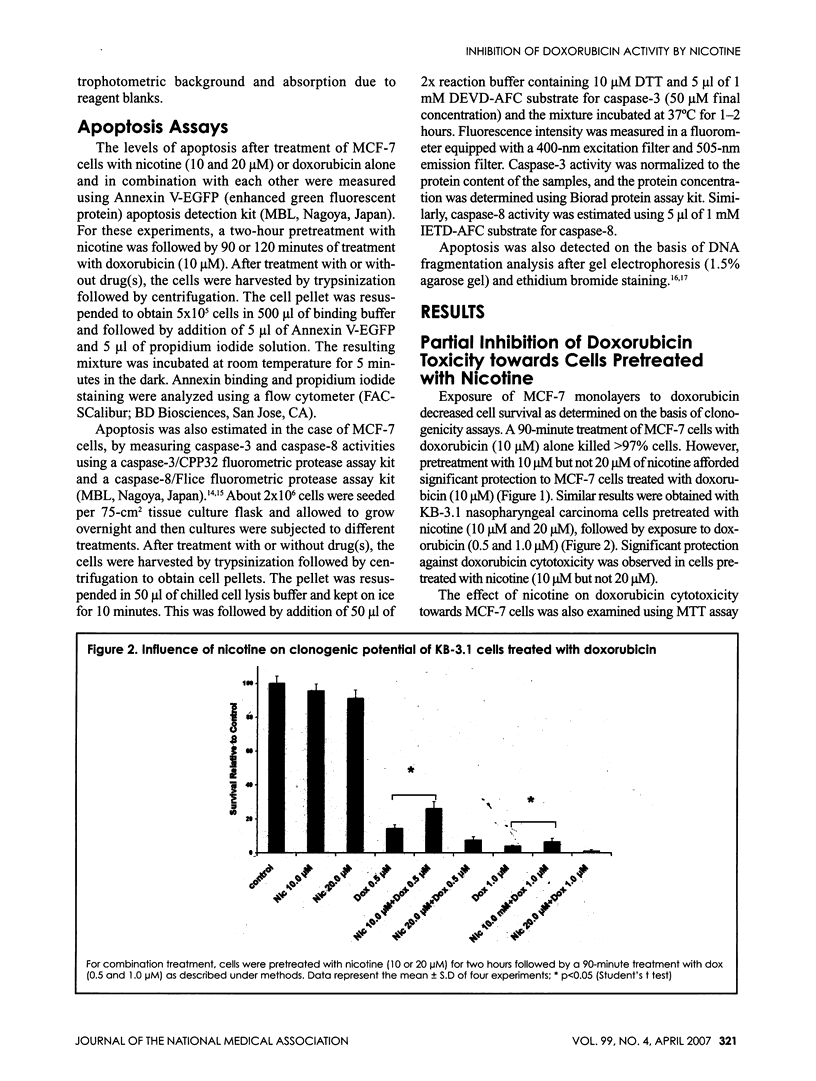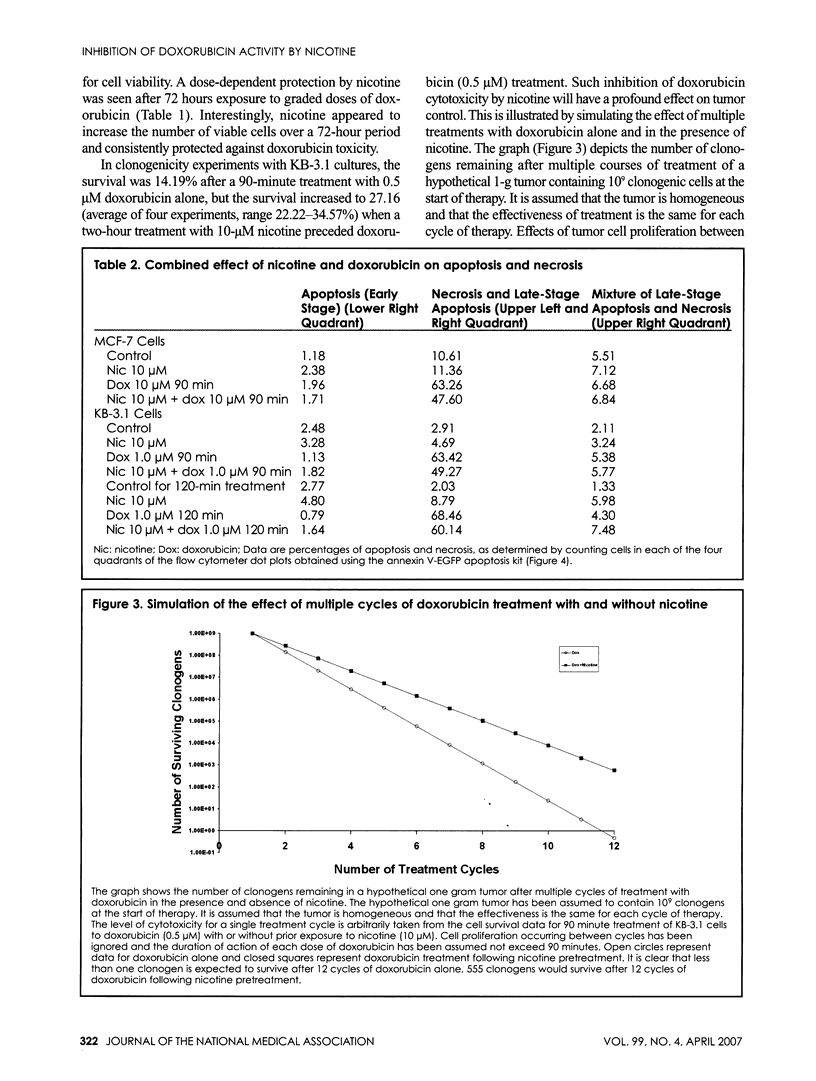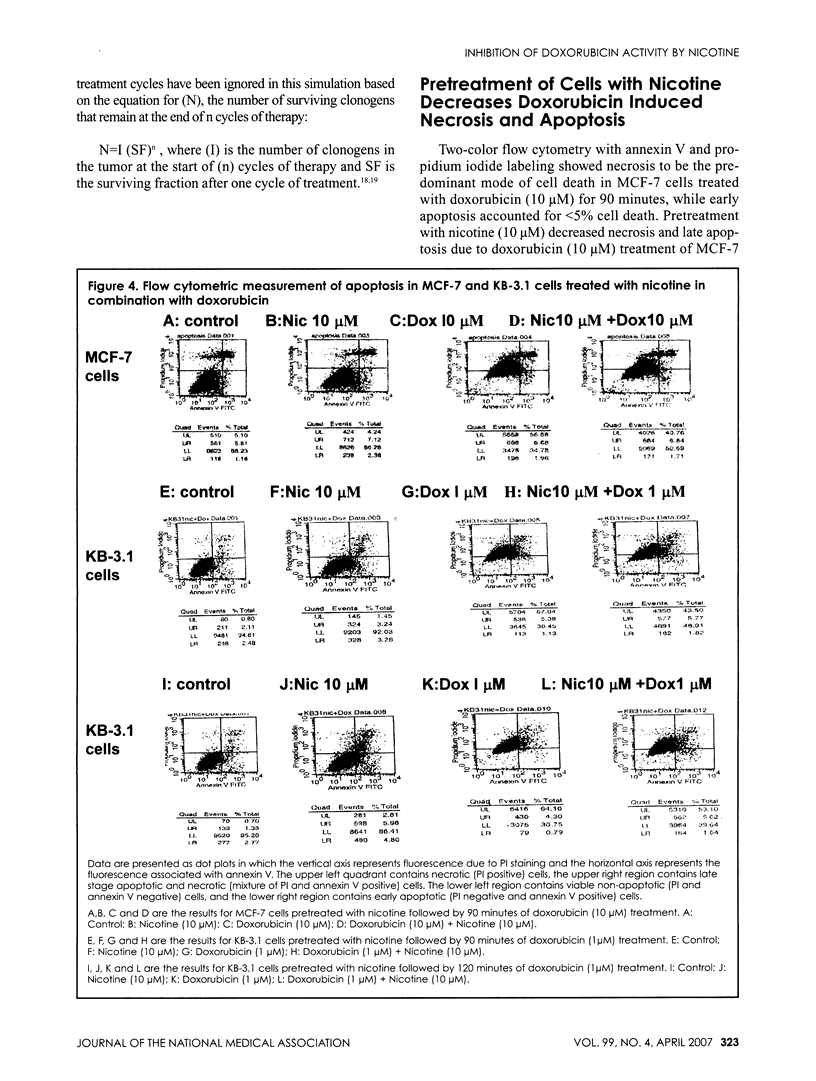Abstract
The harmful effects of tobacco use and nicotine are well known. There is strong epidemiological evidence for smoking as a risk factor for cancer of the lung and oral cavity. The evidence for second-hand smoke as a risk factor for breast cancer is rapidly accumulating. The anthracycline doxorubicin is used in the treatment of many types of malignancies, including breast cancer. The effect of nicotine on doxorubicin toxicity was evaluated in MCF-7 and KB-3.1 cancer cell cultures. Nicotine partially inhibited doxorubicin toxicity towards MCF-7 and KB-3.1 cells, as judged by clonogenicity and flow cytometry assays. Flow cytometric analysis showed that < 10% of cells treated with doxorubicin underwent apoptosis, while necrosis was the major mode of cell death. Inhibition of apoptosis and necrosis in cancer cells by nicotine can diminish the effectiveness of doxorubicin in cancer therapy.
Full text
PDF








Images in this article
Selected References
These references are in PubMed. This may not be the complete list of references from this article.
- Alles A., Alley K., Barrett J. C., Buttyan R., Columbano A., Cope F. O., Copelan E. A., Duke R. C., Farel P. B., Gershenson L. E. Apoptosis: a general comment. FASEB J. 1991 May;5(8):2127–2128. doi: 10.1096/fasebj.5.8.2022310. [DOI] [PubMed] [Google Scholar]
- Benowitz N. L., Jacob P., 3rd, Denaro C., Jenkins R. Stable isotope studies of nicotine kinetics and bioavailability. Clin Pharmacol Ther. 1991 Mar;49(3):270–277. doi: 10.1038/clpt.1991.28. [DOI] [PubMed] [Google Scholar]
- Berger M. R., Zeller W. J. Interaction of nicotine with anticancer treatment. Klin Wochenschr. 1988;66 (Suppl 11):127–133. [PubMed] [Google Scholar]
- Brown J. Martin, Attardi Laura D. The role of apoptosis in cancer development and treatment response. Nat Rev Cancer. 2005 Mar;5(3):231–237. doi: 10.1038/nrc1560. [DOI] [PubMed] [Google Scholar]
- Connor C. E., Burrows J., Hearps A. C., Woods G. M., Lowenthal R. M., Ragg S. J. Cell cycle arrest of hematopoietic cell lines after treatment with ceramide is commonly associated with retinoblastoma activation. Cytometry. 2001 Mar 1;43(3):164–169. doi: 10.1002/1097-0320(20010301)43:3<164::aid-cyto1044>3.0.co;2-o. [DOI] [PubMed] [Google Scholar]
- Crowley-Weber Cara L., Dvorakova Katerina, Crowley Cheray, Bernstein Harris, Bernstein Carol, Garewal Harinder, Payne Claire M. Nicotine increases oxidative stress, activates NF-kappaB and GRP78, induces apoptosis and sensitizes cells to genotoxic/xenobiotic stresses by a multiple stress inducer, deoxycholate: relevance to colon carcinogenesis. Chem Biol Interact. 2003 Mar 6;145(1):53–66. doi: 10.1016/s0009-2797(02)00162-x. [DOI] [PubMed] [Google Scholar]
- Dasgupta Piyali, Kinkade Rebecca, Joshi Bharat, Decook Christina, Haura Eric, Chellappan Srikumar. Nicotine inhibits apoptosis induced by chemotherapeutic drugs by up-regulating XIAP and survivin. Proc Natl Acad Sci U S A. 2006 Apr 6;103(16):6332–6337. doi: 10.1073/pnas.0509313103. [DOI] [PMC free article] [PubMed] [Google Scholar]
- Desai P. B., Bhardwaj R., Damle B. Effect of tamoxifen on mitoxantrone cytotoxicity in drug-sensitive and multidrug-resistant MCF-7 cells. Cancer Chemother Pharmacol. 1995;36(5):368–372. doi: 10.1007/BF00686184. [DOI] [PubMed] [Google Scholar]
- Dewar Brian J., Bradford Blair U., Thurman Ronald G. Nicotine increases hepatic oxygen uptake in the isolated perfused rat liver by inhibiting glycolysis. J Pharmacol Exp Ther. 2002 Jun;301(3):930–937. doi: 10.1124/jpet.301.3.930. [DOI] [PubMed] [Google Scholar]
- Engineer F. N., Sridhar R. Attenuation of daunorubicin-augmented microsomal lipid peroxidation and oxygen consumption by calcium channel antagonists. Biochem Biophys Res Commun. 1991 Sep 16;179(2):1101–1106. doi: 10.1016/0006-291x(91)91933-4. [DOI] [PubMed] [Google Scholar]
- Forrest G. L., Gonzalez B., Tseng W., Li X., Mann J. Human carbonyl reductase overexpression in the heart advances the development of doxorubicin-induced cardiotoxicity in transgenic mice. Cancer Res. 2000 Sep 15;60(18):5158–5164. [PubMed] [Google Scholar]
- Garrido R., Mattson M. P., Hennig B., Toborek M. Nicotine protects against arachidonic-acid-induced caspase activation, cytochrome c release and apoptosis of cultured spinal cord neurons. J Neurochem. 2001 Mar;76(5):1395–1403. doi: 10.1046/j.1471-4159.2001.00135.x. [DOI] [PubMed] [Google Scholar]
- Gritz Ellen R., Dresler Carolyn, Sarna Linda. Smoking, the missing drug interaction in clinical trials: ignoring the obvious. Cancer Epidemiol Biomarkers Prev. 2005 Oct;14(10):2287–2293. doi: 10.1158/1055-9965.EPI-05-0224. [DOI] [PubMed] [Google Scholar]
- Guan Zhi-Zhong, Yu Wen-Feng, Nordberg Agneta. Dual effects of nicotine on oxidative stress and neuroprotection in PC12 cells. Neurochem Int. 2003 Aug;43(3):243–249. doi: 10.1016/s0197-0186(03)00009-3. [DOI] [PubMed] [Google Scholar]
- Hakki A., Friedman H., Pross S. Nicotine modulation of apoptosis in human coronary artery endothelial cells. Int Immunopharmacol. 2002 Sep;2(10):1403–1409. doi: 10.1016/s1567-5769(02)00059-0. [DOI] [PubMed] [Google Scholar]
- Hakki A., Pennypacker K., Eidizadeh S., Friedman H., Pross S. Nicotine inhibition of apoptosis in murine immune cells. Exp Biol Med (Maywood) 2001 Nov;226(10):947–953. doi: 10.1177/153537020122601011. [DOI] [PubMed] [Google Scholar]
- Jang Mi-Hyeon, Shin Min-Chul, Jung Sae-Bin, Lee Taeck-Hyun, Bahn Geon-Ho, Kwon Yunhee Kim, Kim Ee-Hwa, Kim Chang-Ju. Alcohol and nicotine reduce cell proliferation and enhance apoptosis in dentate gyrus. Neuroreport. 2002 Aug 27;13(12):1509–1513. doi: 10.1097/00001756-200208270-00004. [DOI] [PubMed] [Google Scholar]
- Jin Zhaohui, Gao Fengqin, Flagg Tammy, Deng Xingming. Nicotine induces multi-site phosphorylation of Bad in association with suppression of apoptosis. J Biol Chem. 2004 Mar 22;279(22):23837–23844. doi: 10.1074/jbc.M402566200. [DOI] [PubMed] [Google Scholar]
- Johnson Kenneth C. Accumulating evidence on passive and active smoking and breast cancer risk. Int J Cancer. 2005 Nov 20;117(4):619–628. doi: 10.1002/ijc.21150. [DOI] [PubMed] [Google Scholar]
- Klugmann F. B., Decorti G., Crivellato E., Candussio L., Mallardi F., Baldini L. Effect of lysosomotropic and membrane active substances on adriamycin uptake and histamine release. Anticancer Res. 1990 Nov-Dec;10(6):1571–1577. [PubMed] [Google Scholar]
- Kotamraju Srigiridhar, Kalivendi Shasi V., Konorev Eugene, Chitambar Christopher R., Joseph Joy, Kalyanaraman B. Oxidant-induced iron signaling in Doxorubicin-mediated apoptosis. Methods Enzymol. 2004;378:362–382. doi: 10.1016/S0076-6879(04)78026-X. [DOI] [PubMed] [Google Scholar]
- Kropp Silke, Chang-Claude Jenny. Active and passive smoking and risk of breast cancer by age 50 years among German women. Am J Epidemiol. 2002 Oct 1;156(7):616–626. doi: 10.1093/aje/kwf093. [DOI] [PubMed] [Google Scholar]
- Lash T. L., Aschengrau A. Active and passive cigarette smoking and the occurrence of breast cancer. Am J Epidemiol. 1999 Jan 1;149(1):5–12. doi: 10.1093/oxfordjournals.aje.a009727. [DOI] [PubMed] [Google Scholar]
- Lee Ho-Young, Oh Seung-Hyun, Woo Jong K., Kim Woo-Young, Van Pelt Carolyn S., Price Roger E., Cody Dianna, Tran Hai, Pezzuto John M., Moriarty Robert M. Chemopreventive effects of deguelin, a novel Akt inhibitor, on tobacco-induced lung tumorigenesis. J Natl Cancer Inst. 2005 Nov 16;97(22):1695–1699. doi: 10.1093/jnci/dji377. [DOI] [PubMed] [Google Scholar]
- Mai Haiqiang, May W. Stratford, Gao Fengqin, Jin Zhaohui, Deng Xingming. A functional role for nicotine in Bcl2 phosphorylation and suppression of apoptosis. J Biol Chem. 2002 Nov 5;278(3):1886–1891. doi: 10.1074/jbc.M209044200. [DOI] [PubMed] [Google Scholar]
- Martin D. S., Bertino J. R., Koutcher J. A. ATP depletion + pyrimidine depletion can markedly enhance cancer therapy: fresh insight for a new approach. Cancer Res. 2000 Dec 15;60(24):6776–6783. [PubMed] [Google Scholar]
- McArdle H. J., Tysoe J. Effect of nicotine on transferrin binding and iron uptake by cultured rat placenta. J Cell Physiol. 1988 Mar;134(3):509–513. doi: 10.1002/jcp.1041340326. [DOI] [PubMed] [Google Scholar]
- Mimnaugh E. G., Gram T. E., Trush M. A. Stimulation of mouse heart and liver microsomal lipid peroxidation by anthracycline anticancer drugs: characterization and effects of reactive oxygen scavengers. J Pharmacol Exp Ther. 1983 Sep;226(3):806–816. [PubMed] [Google Scholar]
- Mimnaugh E. G., Trush M. A., Gram T. E. Enhancement of rat heart microsomal lipid peroxidation following doxorubicin treatment in vivo. Cancer Treat Rep. 1983 Jul-Aug;67(7-8):731–733. [PubMed] [Google Scholar]
- Minotti Giorgio, Recalcati Stefania, Menna Pierantonio, Salvatorelli Emanuela, Corna Gianfranca, Cairo Gaetano. Doxorubicin cardiotoxicity and the control of iron metabolism: quinone-dependent and independent mechanisms. Methods Enzymol. 2004;378:340–361. doi: 10.1016/S0076-6879(04)78025-8. [DOI] [PubMed] [Google Scholar]
- Mu Y. M., Yanase T., Nishi Y., Tanaka A., Saito M., Jin C. H., Mukasa C., Okabe T., Nomura M., Goto K. Saturated FFAs, palmitic acid and stearic acid, induce apoptosis in human granulosa cells. Endocrinology. 2001 Aug;142(8):3590–3597. doi: 10.1210/endo.142.8.8293. [DOI] [PubMed] [Google Scholar]
- Nair U., Bartsch H. Metabolic polymorphisms as susceptibility markers for lung and oral cavity cancer. IARC Sci Publ. 2001;154:271–290. [PubMed] [Google Scholar]
- Newman Mary B., Arendash Gary W., Shytle R. Douglas, Bickford Paula C., Tighe Thomas, Sanberg Paul R. Nicotine's oxidative and antioxidant properties in CNS. Life Sci. 2002 Nov 1;71(24):2807–2820. doi: 10.1016/s0024-3205(02)02135-5. [DOI] [PubMed] [Google Scholar]
- Olson Lisa E., Bedja Djahida, Alvey Sara J., Cardounel A. J., Gabrielson Kathleen L., Reeves Roger H. Protection from doxorubicin-induced cardiac toxicity in mice with a null allele of carbonyl reductase 1. Cancer Res. 2003 Oct 15;63(20):6602–6606. [PubMed] [Google Scholar]
- Onoda N., Nehmi A., Weiner D., Mujumdar S., Christen R., Los G. Nicotine affects the signaling of the death pathway, reducing the response of head and neck cancer cell lines to DNA damaging agents. Head Neck. 2001 Oct;23(10):860–870. doi: 10.1002/hed.1125. [DOI] [PubMed] [Google Scholar]
- Ravikumar R., Flora Govinder, Geddes James W., Hennig Bernhard, Toborek Michal. Nicotine attenuates oxidative stress, activation of redox-regulated transcription factors and induction of proinflammatory genes in compressive spinal cord trauma. Brain Res Mol Brain Res. 2004 May 19;124(2):188–198. doi: 10.1016/j.molbrainres.2004.02.018. [DOI] [PubMed] [Google Scholar]
- Scott Susan L., Gumerlock Paul H., Beckett Laurel, Li Yueju, Goldberg Zelanna. Survival and cell cycle kinetics of human prostate cancer cell lines after single- and multifraction exposures to ionizing radiation. Int J Radiat Oncol Biol Phys. 2004 May 1;59(1):219–227. doi: 10.1016/j.ijrobp.2004.01.027. [DOI] [PubMed] [Google Scholar]
- Sinha B. K., Trush M. A., Kennedy K. A., Mimnaugh E. G. Enzymatic activation and binding of adriamycin to nuclear DNA. Cancer Res. 1984 Jul;44(7):2892–2896. [PubMed] [Google Scholar]
- Steel G. G. The case against apoptosis. Acta Oncol. 2001;40(8):968–975. doi: 10.1080/02841860152708251. [DOI] [PubMed] [Google Scholar]
- Sugano N., Ito K. Nicotine switches the form of H(2)O(2)-induced cell death from apoptosis to necrosis in U937 cells. Immunol Lett. 2000 Jun 1;72(3):163–166. doi: 10.1016/s0165-2478(00)00181-4. [DOI] [PubMed] [Google Scholar]
- Tsurutani Junji, Castillo S. Sianna, Brognard John, Granville Courtney A., Zhang Chunyu, Gills Joell J., Sayyah Jacqueline, Dennis Phillip A. Tobacco components stimulate Akt-dependent proliferation and NFkappaB-dependent survival in lung cancer cells. Carcinogenesis. 2005 Mar 24;26(7):1182–1195. doi: 10.1093/carcin/bgi072. [DOI] [PubMed] [Google Scholar]
- Wu Yu-Ping, Kita Kazuko, Suzuki Nobuo. Involvement of human heat shock protein 90 alpha in nicotine-induced apoptosis. Int J Cancer. 2002 Jul 1;100(1):37–42. doi: 10.1002/ijc.10449. [DOI] [PubMed] [Google Scholar]
- Xin Meiguo, Deng Xingming. Nicotine inactivation of the proapoptotic function of Bax through phosphorylation. J Biol Chem. 2005 Jan 10;280(11):10781–10789. doi: 10.1074/jbc.M500084200. [DOI] [PubMed] [Google Scholar]
- Xu X., Persson H. L., Richardson D. R. Molecular pharmacology of the interaction of anthracyclines with iron. Mol Pharmacol. 2005 May 9;68(2):261–271. doi: 10.1124/mol.105.013383. [DOI] [PubMed] [Google Scholar]
- Yanagihara K., Nii M., Numoto M., Kamiya K., Tauchi H., Sawada S., Seito T. Radiation-induced apoptotic cell death in human gastric epithelial tumour cells; correlation between mitotic death and apoptosis. Int J Radiat Biol. 1995 Jun;67(6):677–685. doi: 10.1080/09553009514550801. [DOI] [PubMed] [Google Scholar]
- Zweier J. L. Iron-mediated formation of an oxidized adriamycin free radical. Biochim Biophys Acta. 1985 Apr 17;839(2):209–213. doi: 10.1016/0304-4165(85)90038-8. [DOI] [PubMed] [Google Scholar]



